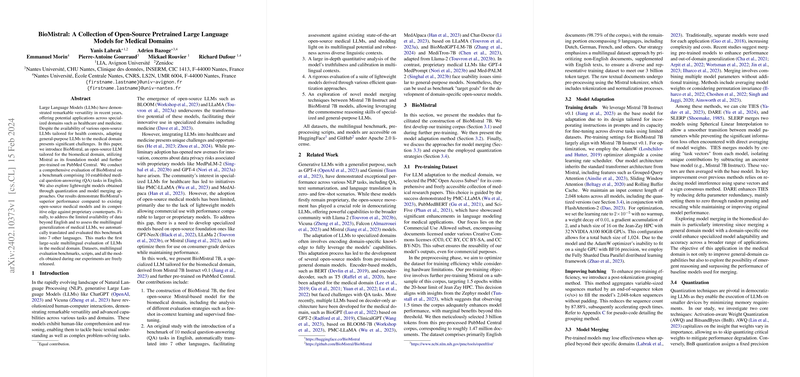Enhancing Medical Domain Understanding with BioMistral: Open-Source Pretrained LLMs
Introduction to BioMistral
The paper presents BioMistral, a set of Open-Source Pretrained LLMs optimized for applications within the medical domain. Based on the Mistral foundation model and enriched by further pretraining on PubMed Central, BioMistral represents a significant step towards making robust, domain-specific NLP capabilities more accessible to researchers and practitioners in the field of healthcare and medicine.
Distinctive Features of BioMistral
BioMistral introduces several innovations and improvements over existing medical LLMs:
- Tailored Domain Optimization: Through further pre-training Mistral on a meticulously curated subset of PubMed Central, BioMistral achieves superior performance on a wide array of medical QA tasks.
- Multilingual Evaluation: It expands the evaluation landscape by translating a benchmark of 10 medical QA tasks into seven languages, thus assessing the multilingual efficacy of medical LLMs at a scale previously unexplored.
- Efficiency through Quantization: Through various quantization and model merging techniques, BioMistral models exhibit not just excellence in performance but also in operational efficiency, making them amenable for deployment on consumer-grade hardware.
Comprehensive Evaluation
BioMistral underwent a rigorous evaluation on a novel benchmark comprising 10 medical QA tasks. It demonstrated statistically significant improvements over other open-source medical models and holds its ground against proprietary models in terms of performance. In multilingual contexts, although there's an observable performance dip compared to English tasks, BioMistral's impressive array of LLMs still outperforms existing models, underscoring its robustness and adaptability across linguistic boundaries.
The Mechanics of Model Adaptation
The adaptation method involves pre-training the Mistral model using a dataset drawn from the PMC Open Access Subset to embed biomedical specificity into BioMistral. This process, aimed at enhancing the model's understanding of complex medical contexts, employs various strategies including AdamW optimization and Grouped-Query Attention, ensuring the model's adeptness at medical domain tasks.
Model Merging and Quantization Strategies
Model merging experiments, using techniques such as SLERP and TIES, indicated that combining specialized and general-domain models can result in improved performance and generalization capabilities. Furthermore, experiments with activation-aware weight quantization and other strategies underscore the potential for deploying BioMistral on devices with limited computational resources without significant loss in performance.
Practical Implications and Future Prospects
BioMistral holds promise for a variety of applications in healthcare and medicine, from enhancing medical literature search capabilities to facilitating patient care through improved understanding of medical queries. Its open-source nature invites further experimentation and adaptation by the global research community. The work paves the way for future developments, particularly in advancing model calibration, reliability, and multilingual capabilities, as well as exploring domain-specific adaptations beyond the sphere of medicine.
Key Contributions
- Domain-Specific Pretraining: Leveraging PubMed Central to train Mistral model variants tailored for the biomedical domain.
- Multilingual Benchmark Creation: Extending the evaluation of medical LLMs to additional languages.
- Advanced Model Quantization: Implementing quantization techniques that allow performance optimization without sacrificing accuracy.
Conclusion
BioMistral represents a significant advancement in the development of domain-specific LLMs for the biomedical field, showing marked improvements over existing models across a range of metrics. By combining the foundational strengths of Mistral with advanced pre-training and model optimization techniques, BioMistral emerges as a powerful tool for researchers and practitioners working at the intersection of AI and healthcare. The open-source release of datasets, benchmarks, and models underlines the authors' commitment to transparency and collaboration in advancing the state of the art in medical NLP.
